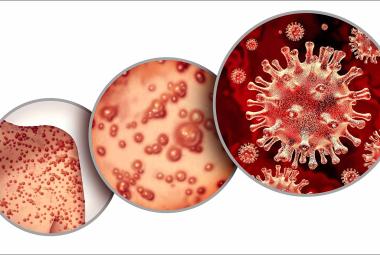Migraines affect up to 17% of women of childbearing age. These headaches are usually one sided and are likely to have a pulsatile or throbbing quality. Accompanying features may include nausea, vomiting, and sensitivity to light or sound. Stress, weather, hunger, menstrual periods, sleep disturbances, light, birth control pills, and certain types of foods can be contributing factors. Migraine headaches are thought to have a multifactorial etiology, and only familial hemiplegic migraines have an established genetic basis.1
Migraine headaches are of two types: with and without aura. An aura, or prodrome, is a subjective feeling that precedes the headache. The appearance of an aura can offer up to 20 minutes warning that a headache is coming. Examples of migraine prodrome include the perception of flashing lights, zigzag lines, scotoma, paresthesia, and language difficulties. The mechanism of migraine headache can be explained by vasodilatation, which plays a major role in the severe, throbbing head pain.1
Migraines tend to get better during pregnancy, especially during the second and third trimesters. Many women who have migraine without aura report 60-70% improvement in terms of decreased intensity and number of attacks, or shorter duration of symptoms. The hyperestrogenic state of pregnancy and the higher pain tolerance of gestation play a major role in this symptomatic relief. Estrogen levels are 30 to 40 times higher during pregnancy, which influences neurological function by facilitating serotonergic and glutamatergic systems. Estrogen and serotonin levels fall after delivery, while increased secretion of substance P from trigeminal nerve endings often leads to painful dilatation of cranial vessels.2, 3
A small percentage of women who suffer from migraine with aura continue to have symptoms during their first trimester. A lack of migraine improvement during the second and third trimesters can be due to prolonged hyperemesis, gestational hypertension, increased anxiety, or the actions of medications they may be taking. These factors can all cancel out the benefits of pregnancy on migraine.2, 3
Though pregnancy can be a sort of grace period for women with migraine, the women who do not show remission of their symptoms still have some increased clinical risks of preeclampsia and thromboembolic events. Recent studies suggest that migraine and preeclampsia share similar features related to coagulation factors, vascular function, platelet activation, and clotting. Migraineurs who are obese carry a 12-fold increased risk of preeclampsia compared with non-obese without migraine. These high-risk patients should be followed carefully by headache specialists and obstetricians.2-5 The available data suggest that leaving migraines untreated has no effect on pregnancy outcomes like congenital abnormalities or fetal loss.2, 6
Women who breastfeed can enjoy a continuation of pregnancy’s protective effect until menstruation returns. Estrogen levels are more stable in a breastfeeding woman and ovulation usually does not occur. Migraine headaches do not appear to affect a woman’s ability to lactate.2, 3, 5, 6
Treatment:
For both pregnant and breastfeeding women, non-pharmacological treatments should be the first-line choice. These techniques are generally safe and effective. A “headache diary” can help to identify triggers and alleviating factors. Over the course of a month or more, this information can guide effective lifestyle changes. Eating regular meals, getting good sleep, staying hydrated, smoking cessation, exercising, and avoiding strong stressors may reduce the number of attacks during pregnancy. Biofeedback techniques have shown a promise in reducing headache frequency and severity with benefits lasting about 1 year after delivery. Relaxation, ice massage, and acupuncture are more effective than oral pharmacologic placebos.1, 3, 5, 6 Transcranial magnetic stimulation has also shown some promise for treatment of headache disorders and is very safe.7
When it comes to drug therapies, there are some unknowns in terms of how safe these compounds are in pregnant or breastfeeding women. Controlled trials in humans are sometimes published for older drugs, but if not, some general principles can help in the assessment (Drugs in Pregnancy, Drugs in Milk). It is probably best to take a “bottom up” approach to therapy, starting with simple choices and using stronger meds only when those fail.
Acetaminophen is the drug of choice to treat migraines during pregnancy and breastfeeding. This drug has an excellent track record of safety in mothers and their babies. Do not take more than 4 grams per day. NSAIDs (e.g. ibuprofen, naproxen) and aspirin are fairly safe in the first and second trimesters, as long as they are used in moderation. They should probably be avoided in the third trimester because they can affect renal development, increase bleeding during delivery, and may contribute to a premature closure of the ductus arteriosus. We discuss NSAIDs and aspirin use in breastfeeding women elsewhere.
Caffeine can make a big difference in the effectiveness of migraine treatments. It is generally safe to use in low doses.3, 5, 6
In terms of prescription medications, the most direct migraine treatments available are the serotonin receptor agonists, also known as the “triptan” class. Sumatriptan (Imitrex) in particular has a good record of safety among pregnant and breastfeeding women. This drug class works by constricting blood vessels, so there is a small but significant risk of problems for a fetus. Substantial pregnancy registry data has established that sumatriptan and naratriptan do not increase the risks of birth defects or miscarriage. A few small studies found a slightly increased risk for premature birth, labor problems, and post-partum hemorrhage associated with this drug.8-10 These risks should be given their due consideration and carefully weighed against the potential benefit of the medication.
Once the baby is born, the risks drop substantially. Both sumatriptan and eletriptan get into the milk in tiny amounts, often less than 1% of the mother’s dose, and are cleared within a few hours. No short-term problems or long-term developmental issues have been documented in breastfeeding infants exposed to these drugs.5, 6, 11 The other “triptans” are probably similar, but they have not been studied as extensively.
Ergotamine and similar drugs are also fairly effective in treating migraines. Unfortunately, they pose a significant hazard to both pregnant and breastfeeding mothers. These drugs are classified as a pregnancy category X by the FDA because they can cause hypertonic uterine contractions and dangerous placental vasoconstriction. In breastfeeding women, they can cause a sharp drop in milk supply.3, 5 The use of these drugs may be more appropriate for women nursing older children that are not as reliant on breastmilk for nutrition, and even then, only in small doses.12, 13
Nausea and vomiting is often associated with migraines and, regrettably, also the use of anti-migraine agents. If severe, nausea or vomiting may require treatment in addition to abortive therapy for an ongoing migraine. Patients may safely find relief with the use of H1 antagonists (meclizine, diphenhydramine) or ondansetron in the case of severe nausea or vomiting.3, 6 Using phenothiazine derivatives (like promethazine or prochlorperazine) during pregnancy does not appear to increase risk of congenital anomalies even though they have been linked to CNS depression. Promethazine may increase the risk of apnea and SIDS in neonates of breastfeeding mothers and should be avoided postnatally.
Migraine prophylaxis can be considered for the pregnant mother if attacks occur at least three to four times per week, are severe enough that they do not respond to non-pharmacologic treatment, require the use of abortive medications that may result in dehydration and fetal distress.14 It is important to note that, while risks exist with all medications used for the treatment or prevention of migraines, there are also risks associated with untreated migraines. Aside from the obvious issues of diminished quality of self-care, infant care, and life in general, migraines are also associated with an increased risk of ischemic stroke.15 Ignoring migraine symptoms may lead to a delay in recognizing that symptoms have changed.
Apart from relaxation techniques and lifestyle changes, some medications and vitamins may help reduce the frequency of attacks in susceptible individuals. Magnesium oxide and high-dose riboflavin (vitamin B2) have evidence supporting their use in as a migraine-prophylactic, are available over the counter, and are safe for use during pregnancy and breastfeeding.3, 11 Some prescription medications, such as propranolol, verapamil, tricyclic antidepressants, and cyproheptadine are reasonable choices for the female migraineur, although they do carry some risk in pregnancy and breastfeeding. It is likely that the benefit to a severely affected patient will outweigh the risk, but that can only be determined on a case-by-case basis. Anti-seizure medications like valproate are often used to prevent migraine headaches but can cause significant problems with neural development when the baby is exposed in-utero or via breastmilk. Specifically, valproate may increase the risk of spinal defects, decreased fetal growth, and significant cognitive delay in older children.16-19
For severe attacks that do not respond to standard treatments, supportive therapy with intravenous hydration and an antiemetic is often necessary.6 According to one study, peripheral nerve blocks may also be effective in refractory cases and do not show any adverse maternal or fetal effects.6 Addtionally, streroids may be useful in intractable cases, with prednisone and methylprednisone being preferred products because they are easily metabolized by the placenta with minimal fetal effects.11
Sai NR Chandamuri, MD
James Abbey, MD
Jesse Vance, PharmD
InfantRisk Center
References:
- Aube M. Migraine in pregnancy. Neurology. 1999;53(4 Suppl 1):S26-28
- Nappi RE, Albani F, Sances G, Terreno E, Brambilla E, Polatti F. Headaches during pregnancy. Current pain and headache reports. Aug 2011;15(4):289-294
- David PS, Kling JM, Starling AJ. Migraine in pregnancy and lactation. Current neurology and neuroscience reports. Apr 2014;14(4):439
- Allais G, Gabellari IC, Borgogno P, De Lorenzo C, Benedetto C. The risks of women with migraine during pregnancy. Neurological sciences : official journal of the Italian Neurological Society and of the Italian Society of Clinical Neurophysiology. Jun 2010;31 Suppl 1:S59-61
- MacGregor EA. Migraine in pregnancy and lactation. Neurological sciences : official journal of the Italian Neurological Society and of the Italian Society of Clinical Neurophysiology. May 2014;35 Suppl 1:61-64
- Men-Jean Lee M. Headache in pregnant and postpartum women. UpToDate. Dec 30, 2014 ed: [UpToDate; 2014.
- Lipton RB, Dodick DW, Silberstein SD, et al. Single-pulse transcranial magnetic stimulation for acute treatment of migraine with aura: a randomised, double-blind, parallel-group, sham-controlled trial. The Lancet. Neurology. Apr 2010;9(4):373-380
- Kallen B, Lygner PE. Delivery outcome in women who used drugs for migraine during pregnancy with special reference to sumatriptan. Headache. Apr 2001;41(4):351-356
- Nezvalova-Henriksen K, Spigset O, Nordeng H. Triptan exposure during pregnancy and the risk of major congenital malformations and adverse pregnancy outcomes: results from the Norwegian Mother and Child Cohort Study. Headache. Apr 2010;50(4):563-575
- Pfaffenrath V, Rehm M. Migraine in pregnancy: what are the safest treatment options? Drug safety. Nov 1998;19(5):383-388
- Hale T, Rowe H. Medications and Mothers' Milk. 16th ed: Hale Publishing; 2014.
- Erkkola R, Kanto J, Allonen H, Kleimola T, Mantyla R. Excretion of methylergometrine (methylergonovine) into the human breast milk. International journal of clinical pharmacology and biopharmacy. Dec 1978;16(12):579-580
- Canales ES, Garrido JT, Zarate A, Mason M, Soria J. Effect of ergonovine on prolactin secretion and milk let-down. Obstetrics and gynecology. Aug 1976;48(2):228-229
- Silberstein SD. Headaches in pregnancy. The journal of headache and pain. Sep 2005;6(4):172-174
- Schurks M, Rist PM, Bigal ME, Buring JE, Lipton RB, Kurth T. Migraine and cardiovascular disease: systematic review and meta-analysis. Bmj. 2009;339:b3914
- Tsuru N, Maeda T, Tsuruoka M. Three cases of delivery under sodium valproate--placental transfer, milk transfer and probable teratogenicity of sodium valproate. The Japanese journal of psychiatry and neurology. Mar 1988;42(1):89-96
- Nau H, Rating D, Koch S, Hauser I, Helge H. Valproic acid and its metabolites: placental transfer, neonatal pharmacokinetics, transfer via mother's milk and clinical status in neonates of epileptic mothers. The Journal of pharmacology and experimental therapeutics. Dec 1981;219(3):768-777
- Veiby G, Engelsen BA, Gilhus NE. Early child development and exposure to antiepileptic drugs prenatally and through breastfeeding: a prospective cohort study on children of women with epilepsy. JAMA neurology. Nov 2013;70(11):1367-1374
- Meador KJ, Baker GA, Browning N, et al. Breastfeeding in children of women taking antiepileptic drugs: cognitive outcomes at age 6 years. JAMA pediatrics. Aug 2014;168(8):729-736







